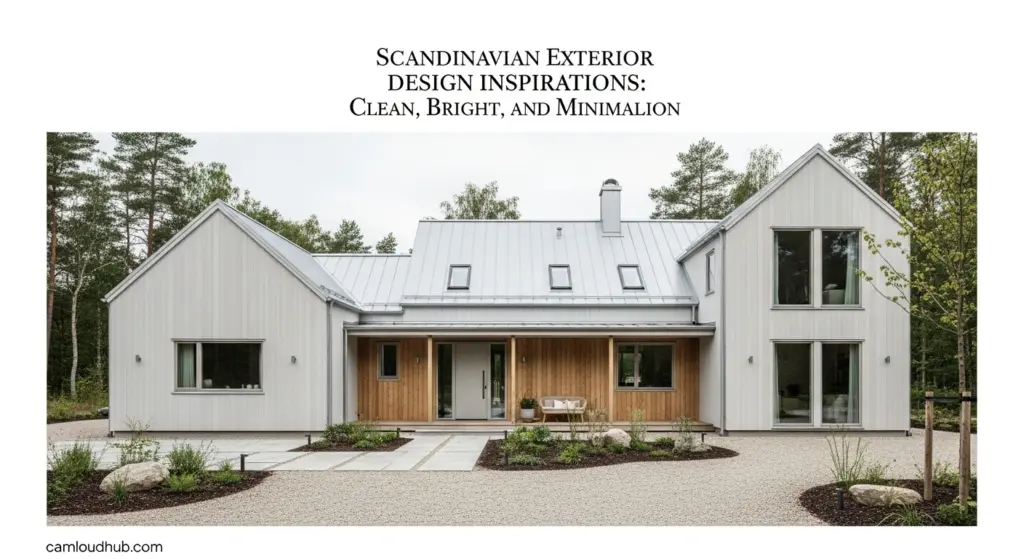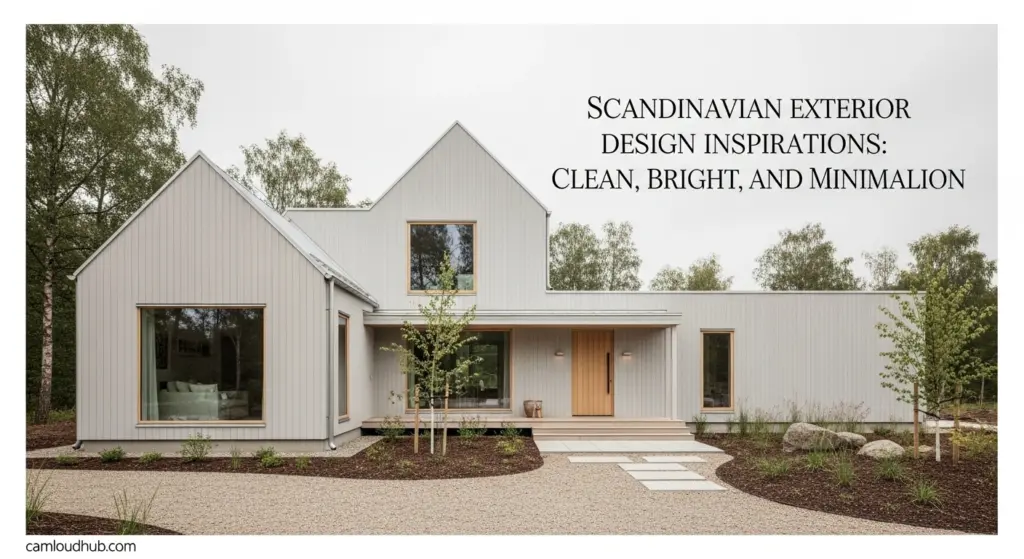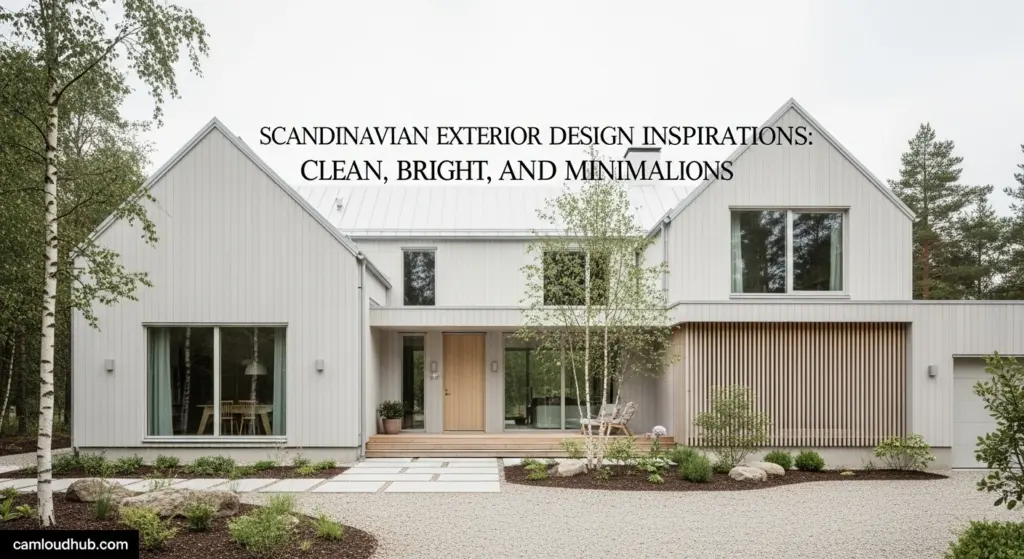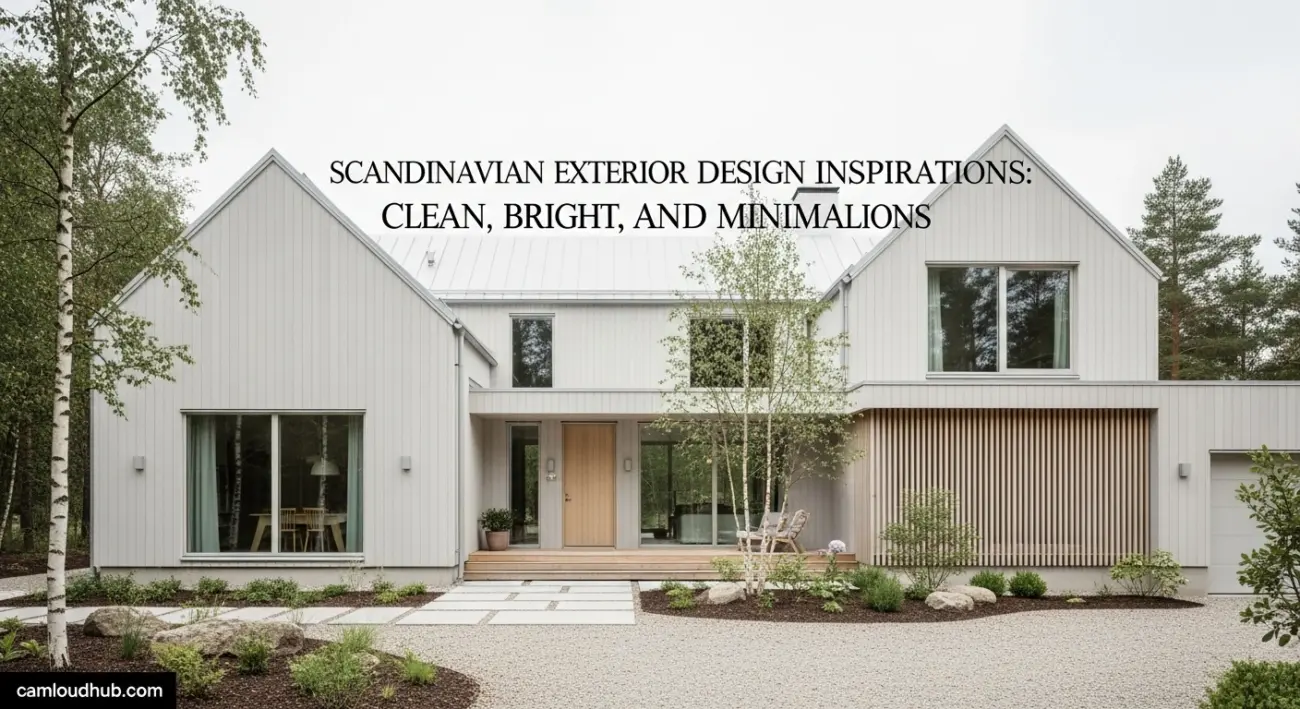Understanding the Essence of Scandinavian Exterior Design
Scandinavian Exterior Design Inspirations – Scandinavian exterior design draws its inspiration from the region’s unique climate and cultural values. The long, dark winters necessitate maximizing light and creating cozy, inviting spaces. This emphasis on functionality and simplicity is reflected in every aspect of the design.
The core principles guiding this style are:
- Functionality: Every element serves a purpose and contributes to the overall usability of the space.
- Simplicity: Embrace clean lines, uncluttered spaces, and a minimalist approach.
- Natural Light: Maximize natural light penetration through large windows and strategic placement of openings.
- Natural Materials: Incorporate wood, stone, and other natural elements to create a connection with the outdoors.
- Neutral Palette: Stick to a calming color scheme of whites, grays, and earthy tones.
- Sustainability: Opt for eco-friendly materials and practices that minimize environmental impact.

The Influence of Nordic Culture and Climate
The harsh climate of Scandinavia has profoundly shaped its design aesthetic. The need to withstand long, dark winters has led to a focus on creating bright, inviting spaces that maximize natural light. Homes are designed to be energy-efficient and well-insulated, protecting occupants from the cold.
Nordic culture also emphasizes a deep connection with nature. This is reflected in the use of natural materials, the incorporation of greenery, and the desire to create a harmonious balance between the built environment and the surrounding landscape. The concept of “hygge,” which embodies coziness, comfort, and well-being, is central to Scandinavian design principles.
Key Characteristics of Scandinavian Exterior Design
Several key characteristics define Scandinavian exterior design:
- Clean Lines: Simple, straight lines dominate the architectural forms, creating a sense of order and clarity.
- Minimalist Details: Avoid unnecessary ornamentation and focus on functional elements.
- Large Windows: Maximize natural light penetration and offer unobstructed views of the surrounding landscape.
- Wood Accents: Utilize wood cladding, trim, and decking to add warmth and texture.
- Neutral Colors: Employ a palette of whites, grays, and earthy tones to create a calming and harmonious atmosphere.
- Greenery Integration: Incorporate plants, trees, and landscaping to connect the building with nature.
- Practical Outdoor Spaces: Design functional and inviting outdoor areas for relaxation and entertainment.
Color Palette for Scandinavian Exteriors: Embracing Nuance
The color palette for Scandinavian exterior design is predominantly neutral, revolving around whites, grays, and earthy tones. However, this doesn’t mean the exteriors are devoid of character. Nuance and subtle variations within the neutral spectrum add depth and personality.
The Power of White: Purity and Light
White is the cornerstone of Scandinavian design, both interior and exterior. It reflects light effectively, brightening spaces and creating an airy feel. Different shades of white, from pure white to off-white and creamy white, can be used to create subtle variations and add warmth. White exteriors provide a clean and timeless look, making them a popular choice for Scandinavian homes.
Consider these aspects when using white:
- Climate: In areas with harsh sunlight, a slightly off-white shade may be preferable to reduce glare.
- Surroundings: The surrounding landscape can influence the choice of white. A warmer white may complement a wooded setting, while a cooler white may suit a coastal environment.
- Contrast: White provides a perfect backdrop for contrasting elements like dark wood trim or black window frames.
Grays: Sophistication and Versatility
Gray is another essential color in the Scandinavian palette. It offers a more sophisticated and versatile alternative to white, adding depth and visual interest. From light grays that mimic the tones of weathered wood to darker charcoal grays, the possibilities are endless. Gray exteriors exude a sense of understated elegance and blend seamlessly with natural surroundings.
Explore the different shades of gray:
- Warm Grays: These have subtle brown or beige undertones, creating a cozy and inviting feel.
- Cool Grays: These have blue or green undertones, creating a more contemporary and refreshing look.
- Charcoal Gray: This dark and dramatic shade can be used as an accent color or for entire facades to create a striking contrast.
Earth Tones: Grounding and Natural
Earth tones like beige, brown, and taupe provide a grounding and natural element to Scandinavian exteriors. These colors evoke the tones of wood, stone, and soil, seamlessly blending the building with its environment. Earth tones can be used for cladding, trim, or accents to add warmth and texture.
Consider these earth-tone options:
- Beige: A light and versatile neutral that complements a variety of architectural styles.
- Brown: Evokes a sense of warmth and stability, often used for wood cladding or trim.
- Taupe: A sophisticated blend of gray and brown, adding depth and visual interest.

Accent Colors: Adding Personality and Flair
While a neutral palette dominates, subtle accent colors can be used to add personality and flair to Scandinavian exteriors. Soft blues, greens, and yellows, inspired by nature, are popular choices. These colors can be incorporated through doors, window frames, shutters, or landscaping elements.
Remember to use accent colors sparingly and strategically:
- Complementary Colors: Choose accent colors that complement the primary color palette.
- Natural Inspiration: Draw inspiration from the surrounding landscape when selecting accent colors.
- Subtlety is Key: Avoid overly bright or bold colors that clash with the overall minimalist aesthetic.
Materials: Connecting with Nature
The choice of materials plays a crucial role in achieving the authentic Scandinavian exterior design. Natural materials like wood, stone, and glass are favored for their warmth, texture, and sustainability. These materials not only enhance the aesthetic appeal but also create a connection with the surrounding environment.
Wood: Warmth, Texture, and Versatility
Wood is the most iconic material in Scandinavian exterior design. It adds warmth, texture, and a natural element to the facade. Wood can be used for cladding, trim, decking, and other architectural details. Different types of wood, such as pine, spruce, and cedar, offer unique characteristics.
Consider these types of wood for your exterior:
- Pine: Affordable and readily available, often used for cladding and decking.
- Spruce: Light-colored and durable, suitable for cladding and trim.
- Cedar: Naturally resistant to decay and insects, ideal for cladding, shingles, and siding.
- ThermoWood: Heat-treated wood that enhances durability and resistance to moisture and decay.
Regardless of the wood species you select, consider applying a sealant or stain to protect it from the elements.
Stone: Durability, Texture, and Natural Beauty
Stone is another popular material in Scandinavian exterior design, adding durability, texture, and natural beauty to the facade. Stone can be used for cladding, foundations, fireplaces, and landscaping elements. Different types of stone, such as granite, slate, and limestone, offer unique textures and colors.
Explore these stone options:
- Granite: A durable and hard stone, often used for foundations and cladding.
- Slate: A fine-grained stone with a distinctive layered appearance, suitable for roofing and cladding.
- Limestone: A sedimentary rock with a soft and porous texture, often used for cladding and decorative elements.
Glass: Transparency, Light, and Connection
Glass is essential for maximizing natural light penetration and creating a connection with the outdoors. Large windows and glass doors allow sunlight to flood the interior spaces, creating a bright and airy atmosphere. Glass can also be used for skylights and greenhouses to further enhance natural lighting.
Maximize glass usage by:
- Large Windows: Install large windows to maximize natural light and views.
- Sliding Glass Doors: Use sliding glass doors to connect indoor and outdoor spaces.
- Skylights: Incorporate skylights to bring natural light into interior spaces.
- Energy-Efficient Glass: Opt for energy-efficient glass to reduce heat loss and gain.
Other Materials: Adding Depth and Interest
While wood, stone, and glass are the primary materials, other materials can be used to add depth and interest to Scandinavian exteriors. Metal, concrete, and brick can be incorporated as accent elements or for specific architectural features.
Consider these additional materials:
- Metal: Adds a modern and industrial touch, often used for roofing, gutters, and trim.
- Concrete: Provides a clean and minimalist look, suitable for foundations, walls, and paving.
- Brick: Adds texture and character, often used for chimneys and accent walls.
Architectural Elements: Defining the Style
Certain architectural elements are characteristic of Scandinavian exterior design. These elements contribute to the overall aesthetic of simplicity, functionality, and connection with nature.
Minimalist Rooflines: Simplicity and Functionality
Scandinavian homes typically feature simple rooflines, such as gabled or flat roofs. These rooflines are designed for functionality and efficiency, allowing for optimal water runoff and snow shedding. The minimalist aesthetic extends to the roof, with clean lines and minimal ornamentation.
The most common roof types are:
- Gabled Roof: A classic roof design with two sloping sides that meet at a ridge.
- Flat Roof: A modern roof design that is almost completely flat, often used in urban areas.
- Shed Roof: A single-sloping roof that is often used for additions or small structures.
Large Windows and Doors: Embracing Natural Light
Large windows and doors are essential for maximizing natural light and creating a connection with the outdoors. These elements are strategically placed to capture sunlight and offer unobstructed views of the surrounding landscape. Large windows and doors also enhance the sense of spaciousness and openness within the home.
Consider maximizing natural light exposure by:
- Window Placement: Position windows to capture optimal sunlight exposure.
- Door Selection: Choose doors with large glass panels to maximize light and views.
- Window Size: Opt for larger windows to increase the amount of natural light entering the home.
Simple Porches and Decks: Outdoor Living
Porches and decks are integral parts of Scandinavian exterior design, providing spaces for outdoor relaxation and entertainment. These spaces are typically simple and functional, with clean lines and minimal ornamentation. They are designed to be extensions of the interior living spaces, blurring the boundaries between indoors and outdoors.
When designing your porch or deck, consider:
- Size and Location: Determine the appropriate size and location based on your needs and the available space.
- Material Selection: Choose durable and weather-resistant materials that complement the overall design.
- Furniture and Accessories: Select simple and comfortable furniture and accessories to create an inviting space.
Integrated Garages: Functional and Discreet
Garages in Scandinavian exterior design are typically integrated into the main structure of the house, creating a seamless and functional design. These garages are often designed to be discreet, blending in with the overall aesthetic of the building. They are typically accessed through a simple door or gate, minimizing visual clutter.
Consider these tips for integrated garage design:
- Material Consistency: Use the same materials and colors as the main house to create a cohesive design.
- Door Style: Choose a simple and minimalist garage door that blends in with the overall aesthetic.
- Landscaping: Use landscaping to screen the garage and soften its appearance.
Landscaping: Bringing Nature Closer
Landscaping plays a vital role in complementing Scandinavian exterior design. The goal is to create a natural and harmonious environment that enhances the beauty of the building. Native plants, simple arrangements, and the absence of excessive ornamentation are key considerations.
Native Plants and Natural Arrangements
Using native plants is an excellent way to connect your home with its surrounding environment. Native plants are well-adapted to the local climate and soil conditions, requiring less maintenance and water. They also attract local wildlife and contribute to the overall biodiversity of the area. Choose plants with varying textures, heights, and colors to create visual interest.
Some popular Native Plant options are:
- Flowering Trees: Birches, rowans, and other native flowering trees add beauty and shade.
- Shrubs: Native shrubs provide privacy and structure to the landscape.
- Groundcover: Native groundcover helps to prevent erosion and suppress weeds.
Minimal Lawn Space and Natural Ground Covers
Large, manicured lawns are typically avoided in Scandinavian landscaping. Instead, focus on minimizing lawn space and incorporating natural ground covers such as moss, gravel, or wood chips. These options require less maintenance and water, creating a more sustainable and eco-friendly landscape.
Other alternatives to lawns are:
- Gravel Paths: Create natural pathways through the landscape using gravel or stepping stones.
- Wood Chip Mulch: Use wood chip mulch to suppress weeds and retain moisture in planting beds.
- Moss Gardens: Create a tranquil and low-maintenance moss garden in shaded areas.
Rock Gardens and Stone Accents
Rock gardens and stone accents add texture and visual interest to Scandinavian landscaping. These elements can be used to create naturalistic features, such as rock outcroppings or dry creek beds. Stone can also be used for retaining walls, pathways, and decorative accents.
A rock garden can be created by:
- Selecting the Right Stones: Choose rocks that are native to your area and vary in size and shape.
- Arranging the Stones: Arrange the stones in a naturalistic pattern, mimicking a rock outcropping.
- Planting Around the Stones: Plant drought-tolerant plants around the stones to create a thriving rock garden.
Water Features: Tranquility and Relaxation
Water features can add tranquility and relaxation to Scandinavian landscaping. Simple water features, such as small ponds or fountains, can create a calming atmosphere and attract wildlife. These features should be designed to blend in with the natural surroundings, using natural materials like stone and wood.
Water feature options are:
- Small Ponds: Create a small pond with native plants and fish to attract wildlife.
- Fountains: Install a simple fountain to add the sound of running water to the landscape.
- Bird Baths: Set up bird baths to attract birds and provide them with a source of fresh water.
Lighting: Illuminating the Minimalism
Lighting is an essential element of Scandinavian exterior design, both for functional and aesthetic purposes. The goal is to create a warm and inviting atmosphere while highlighting the architectural features of the building.
Warm and Subtle Lighting Fixtures
Choose warm and subtle lighting fixtures and avoid harsh or overly bright lights. Soft, diffused light creates a more relaxing and inviting atmosphere. Opt for fixtures with a warm color temperature, mimicking the glow of natural light.
Consider these lighting fixture options:
- Lanterns: Add a touch of rustic charm with traditional lanterns.
- Wall Sconces: Provide ambient light and highlight architectural details with wall sconces.
- Path Lights: Illuminate pathways and driveways with discreet path lights.
Strategic Placement of Lights
Strategic placement of lights is crucial for achieving the desired effect. Focus on highlighting key architectural features, such as the front door, windows, and landscaping elements. Avoid over-lighting the facade, which can create a harsh and unnatural look.
Some suggestions on light placement design are:
- Highlighting Architectural Features: Use spotlights to highlight the front door, windows, and other architectural details.
- Illuminating Pathways: Use path lights to illuminate pathways and driveways, ensuring safety and accessibility.
- Accenting Landscaping: Use uplights to accent trees, shrubs, and other landscaping elements.
Energy-Efficient Lighting Options
Opt for energy-efficient lighting options, such as LED bulbs, to reduce energy consumption and environmental impact. LED bulbs are long-lasting and consume significantly less energy than traditional incandescent bulbs. They also come in a variety of color temperatures, allowing you to customize the lighting to your liking.
benefits of energy-efficient lighting:
- Reduced Energy Consumption: LED bulbs consume up to 80% less energy than traditional incandescent bulbs.
- Long Lifespan: LED bulbs have a lifespan of up to 25,000 hours, lasting much longer than traditional bulbs.
- Variety of Color Temperatures: LED bulbs come in a variety of color temperatures, allowing you to choose the perfect lighting for your needs.
Scandinavian Exterior Design Inspirations: Examples
Now, let’s look at some examples of Scandinavian exterior design to gather inspiration for your own project.
Coastal Scandinavian Style
Coastal Scandinavian exterior design embraces the beauty of the seaside, incorporating elements like light blue or gray accents, weathered wood, and nautical-inspired details. The design often prioritizes maximizing views of the water and creating a seamless connection between the indoor and outdoor spaces.
Key elements of Coastal Scandinavian Design:
- Light Colors: Utilize a palette of light blues, grays, and whites to reflect the coastal environment.
- Weathered Wood: Embrace the natural look of weathered wood for cladding, decking, and trim.
- Nautical Details: Incorporate nautical-inspired elements, such as rope accents, ship-lap siding, and maritime-themed lighting.
Modern Scandinavian Style
Modern Scandinavian exterior design combines minimalist principles with contemporary architectural forms. This style often features clean lines, geometric shapes, and a monochromatic color palette with pops of accent colors.
Key features of Modern Scandinavian Design:
- Geometric Forms: Embrace clean lines and geometric shapes in the architectural design.
- Monochromatic Palette: Stick to a monochromatic palette of whites, grays, and blacks.
- Bold Accents: Incorporate bold accent colors, such as red, yellow, or blue, to add visual interest.
Rural Scandinavian Style
Rural Scandinavian exterior design embraces the rustic charm of the countryside, incorporating natural materials like wood and stone in their rawest forms. This style often features exposed beams, handcrafted details, and a warm, earthy color palette.
Key features of Rural Scandinavian Design:
- Raw Materials: Utilize natural materials like wood and stone in their rawest forms.
- Exposed Beams: Feature exposed beams to add rustic charm and character.
- Warm Color Palette: Embrace a warm, earthy color palette inspired by the natural landscape.
Minimalist Scandinavian Style
Minimalist Scandinavian exterior design strips away all unnecessary ornamentation, focusing on functionality and simplicity. This style features clean lines, a neutral color palette, and a minimalist approach to landscaping.
Key features of Minimalist Scandinavian Design:
- Clean Lines: Prioritize clean lines and uncluttered spaces.
- Neutral Palette: Stick to a neutral color palette of whites, grays, and blacks.
- Minimal Landscaping: Keep landscaping simple and natural, avoiding excessive ornamentation.
These different styles of Scandinavian exteriors show that it’s not just one set look, but a set of design principles and philosophies that when combined can achieve a tranquil and aesthetically pleasing end result.

Maintaining Your Scandinavian Exterior Design
Maintaining the beauty and longevity of your Scandinavian exterior design requires regular care and attention. Proper maintenance will not only protect your investment but also preserve the aesthetic appeal of your home.
Cleaning and Protecting Wood Surfaces
Wood surfaces are susceptible to weathering and decay, so it’s crucial to clean and protect them regularly. Clean wood surfaces with a mild soap and water solution, removing any dirt, mildew, or algae. Apply a sealant or stain every few years to protect the wood from moisture, UV rays, and pests.
Follow these steps for wood maintenance:
- Clean Regularly: Clean wood surfaces with a mild soap and water solution every few months.
- Apply Sealant or Stain: Apply a sealant or stain every few years to protect the wood from the elements.
- Inspect for Damage: Regularly inspect wood surfaces for signs of damage, such as rot, cracks, or insect infestation.
Caring for Stone and Masonry
Stone and masonry surfaces are durable but can still accumulate dirt and grime over time. Clean stone and masonry surfaces with a pressure washer or a brush and water. Apply a sealant to protect the stone from staining and weathering.
Here’s how to maintain your stone surfaces:
- Clean Periodically: Clean stone and masonry surfaces with a pressure washer or a brush and water every year.
- Apply Sealant: Apply a sealant to protect the stone from staining and weathering.
- Repair Cracks and Damage: Repair any cracks or damage to the stone or masonry as soon as possible to prevent further deterioration.
Maintaining Landscaping
Regular maintenance is essential for keeping your Scandinavian landscaping healthy and attractive. Weed regularly, prune shrubs and trees, and fertilize plants as needed. Mulch planting beds to suppress weeds and retain moisture.
Here are the Landscaping Maintenance guidelines:
- Weed Regularly: Weed planting beds regularly to prevent weeds from competing with your plants.
- Prune Shrubs and Trees: Prune shrubs and trees as needed to maintain their shape and health.
- Fertilize Plants: Fertilize plants as needed to promote healthy growth.
- Mulch Planting Beds: Mulch planting beds to suppress weeds and retain moisture.
- Water Plants: Water plants as needed to keep them healthy and hydrated, especially during dry periods.
Conclusion
Scandinavian exterior design offers a timeless and elegant approach to creating a harmonious and inviting home. By embracing simplicity, functionality, and a deep connection with nature, you can transform your home’s facade into a minimalist masterpiece. Incorporating the key elements of Scandinavian exterior design – a neutral color palette, natural materials, clean lines, and thoughtful landscaping – will create a space that is both beautiful and functional, adding lasting value to your home. The core principles of Scandinavian exterior design remain a guiding force in modern architecture, offering a serene and sustainable approach to home design.


